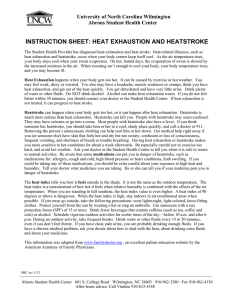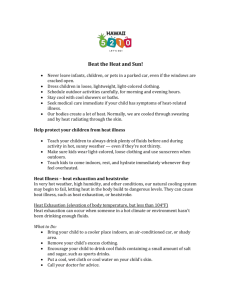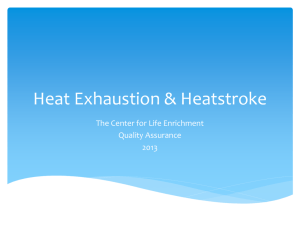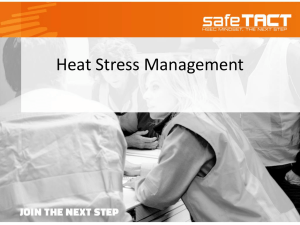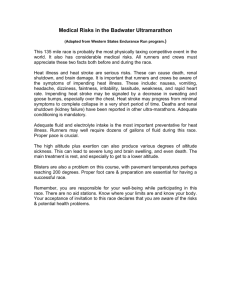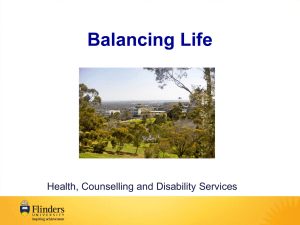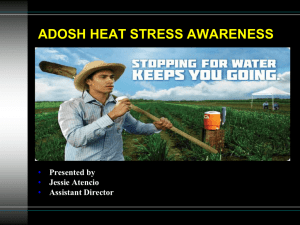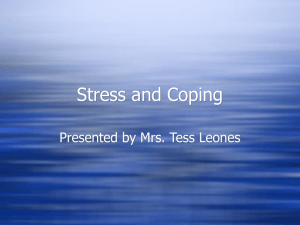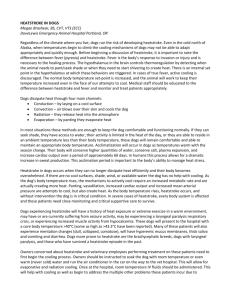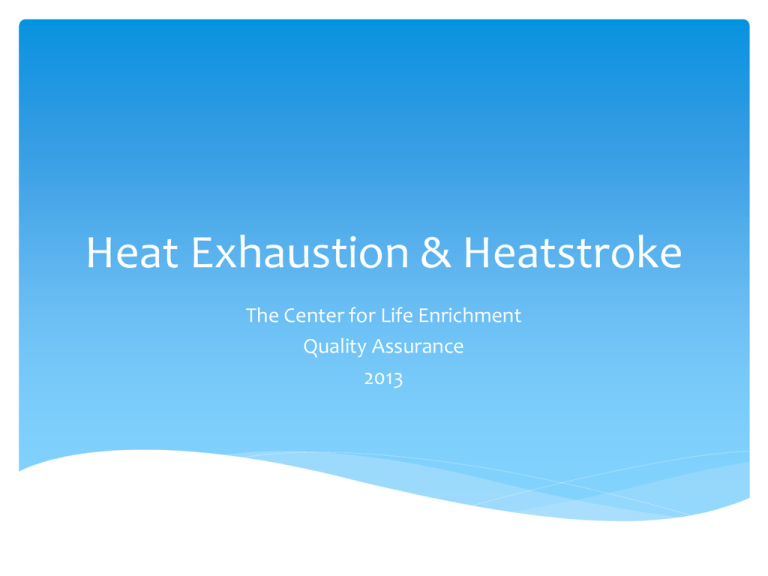
Heat Exhaustion & Heatstroke
The Center for Life Enrichment
Quality Assurance
2013
Section 1
Heat Exhaustion
Heat Exhaustion
Heat exhaustion is a heat-related illness that can
occur after you’ve been exposed to high
temperatures for a period of time and have become
dehydrated
Heat exhaustion is one of three heat-related
syndromes, with heat cramps being the mildest and
heatstroke being the most severe
Causes of Heat-Related Illnesses
Causes of heat exhaustion include exposure to high
temperatures, particularly when combined with high
humidity and strenuous physical activity
Without prompt treatment, heat exhaustion can lead
to heatstroke, a life-threatening condition
Heat exhaustion and heatstroke are preventable!
Risk Factors for Heat Exhaustion
Heat exhaustion is strongly related to the heat index
The risk of heat-related illness dramatically increases when the
heat index climbs to 91 F or higher
It’s extremely important, especially during heat waves, to pay
attention to the reported heat index
Remember that the heat index is even higher when you are
standing in full sun
If you live in an urban area, you may be especially prone to
develop heat exhaustion during a prolonged heat wave; asphalt
and concrete store heat during the day and only gradually
release it at night, resulting in higher nighttime temperatures
Heat Index
The heat index is given in
degrees Fahrenheit
The heat index is a measure of
how hot it really feels when
relative humidity is factored in
with the actual air
temperature
When the humidity is high,
your sweat can’t evaporate as
easily, and your body has more
difficulty cooling itself, making
you prone to heat exhaustion
and heatstroke
When the heat index is 91 F or
higher, you should take
precautions to keep cool
Other Risk Factors
Age: Infants and children up to age 4, and adults over age 65, are
particularly vulnerable because they adjust to heat more slowly
than other people
Certain Health Conditions: Including heart, lung, or kidney
disease, obesity or underweight, high blood pressure, diabetes,
mental illness, sickle cell trait, alcoholism, sunburn, and any
conditions that cause fever
Medications: Including diuretics, sedatives, tranquilizers,
stimulants, some heart and blood pressure medications, and
medications for psychiatric conditions
Check with your doctor to see if your health conditions and
medications are likely to affect your ability to cope with extreme
heat and humidity
Symptoms of Heat Exhaustion
The most common signs and symptoms of heat exhaustion include:
Confusion
Dark-colored urine (a sign of dehydration)
Dizziness
Fainting
Fatigue
Headache
Muscle cramps
Nausea
Pale Skin
Cool, moist skin with goose bumps when in the heat
Excessive sweating
Weak or rapid heartbeat
Low blood pressure upon standing
Signs and symptoms of heat exhaustion may develop suddenly, or over time, especially with
prolonged periods of exercise/physical activity
Treatment of Heat Exhaustion
If you think a person may be experiencing heat exhaustion:
Immediately get out of the heat and rest, preferably in an airconditioned room
If you cannot get inside, try to find the nearest cool and shady
place
Drink plenty of fluids (avoid caffeine and alcohol)
Remove any tight or unnecessary clothing
Take a cool shower, bath, or sponge bath
Apply other cooling measures such as fans or ice towels
If such measures fail to provide relief within 30 minutes,
contact your doctor
Take Precautions
After you’ve recovered from heat exhaustion, you
may be more sensitive to high temperatures during
the following week
It’s best to avoid hot weather and heavy exercise until
your doctor tells you that it’s safe to resume your
normal activities
Section 2
Heatstroke
Heatstroke
Heatstroke is caused by prolonged exposure to high
temperatures or by doing physical activity in hot weather
You are considered to have heatstroke when your body
temperature reaches 104 F or higher
Heatstroke is the most serious form of heat injury and is a
medical emergency
A possible complication of heatstroke is shock, which is a
condition caused by a sudden loss of blood flow
Signs of shock include a very low blood pressure, blue lips and
nails, and cool, clammy skin
Heatstroke can kill or cause damage to the brain and other
internal organs
Causes of Heatstroke
Exposure to a hot environment
Strenuous activity
Wearing excessive clothing
Drinking alcohol
Becoming dehydrated
Risk Factors
Anyone can develop heatstroke, but several factors place you at
increased risk:
Age: Infants and children up to age 4, and adults over age 65, are
particularly vulnerable because they adjust to heat more slowly
than other people
Health Conditions: Including heart, lung, or kidney disease,
obesity or underweight, high blood pressure, diabetes, mental
illness, sickle cell trait, alcoholism, sunburn, and any conditions
that cause fever
Medications: Including antihistamines, diet pills, diuretics,
sedatives, tranquilizers, stimulants, seizure medications, heart
and blood pressure medications, and medications for psychiatric
illnesses
Symptoms of Heatstroke
A body temperature of 104 F or higher is the main sign of heatstroke
Fainting
Throbbing headache
Dizziness and light-headedness
Lack of sweating despite the heat
Red, hot, and dry skin
Muscle weakness or cramps
Nausea and vomiting
Rapid heartbeat, which may be either strong or weak
Rapid, shallow breathing
Behavioral changes such as confusion, disorientation, or staggering
Seizures
Unconsciousness
Treatment of Heatstroke
If you think a person may be experiencing heatstroke, seek
immediate medical help
Call 911
Take immediate action to cool the overheated person
while waiting for emergency treatment
Help the person move to a shaded location and remove
excess clothing
Place ice packs or cold, wet towels on the person’s head,
neck, armpits, and groin
Mist the person with water while a fan is blowing on him
or her
Section 3
Preventing Heat-Related
Illnesses
Preventing Heat-Related Illnesses
When the heat index is high, it’s best to stay inside in
air conditioning
If you must go outdoors, you can prevent heat
exhaustion by taking these steps:
Wear lightweight, light-colored, loose-fitting clothing,
and a wide-brimmed hat
Avoid sunburn; use a sunscreen with an SPF of 30 or
higher. Having a sunburn reduces your body’s ability to
rid itself of heat
Preventing Heat-Related Illnesses:
Drink Extra Fluids
To prevent dehydration, it’s generally recommended to drink at least 8
glasses of water per day. Because heat-related illness also can result from
salt depletion, it may be advisable to substitute an electrolyte-rich sports
drink for water during periods of extreme heat and humidity
Take additional precautions when working outdoors or doing physical
activity/exercise. The general recommendation is to drink 24 ounces of fluid
two hours before exercise, and consider adding another 8 ounces of water
or sports drink right before exercise
During exercise, you should consume another 8 ounces of water every 20
minutes even if you don’t feel thirsty
Avoid fluids containing either caffeine or alcohol, because both substances
can make you lose more fluids and worsen heat exhaustion
If you have epilepsy or heart, kidney, or liver disease; are on fluid-restricted
diets; or have a problem with fluid retention, check with your doctor before
increasing liquid intake
The Dangers of Heat in a Parked Car
On a hot day, the temperature in your parked car can rise
20 F in just 10 minutes!
Let your car cool down before you drive it
Never leave anyone in a parked car in hot weather for any
period of time
In slide show mode, click the link below or copy & paste the link
in your web browser to view the video:
“So how hot is it in your car?” http://youtu.be/SSnxFea-_eA
Resources
www.webmd.com
www.mayoclinic.com
www.nws.noaa.gov
www.youtube.com

